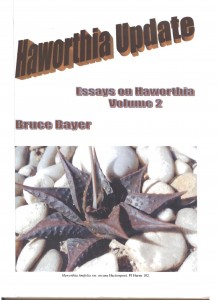This article was first published in Aloe 36:34, (1999) and is now rewritten in part to accommodate some new collections and a conclusion modified accordingly.
The problem:-
Von Poellnitz described Haworthia incurvula (Feddes Repertorium 31:85, 1932), from specimens ostensibly from Grahamstown, sent to him by Mrs. E. Ferguson. The important elements of the description are.. “leaves about 40, barely 20mm long, up to 12mm wide, broad ovate-oblong, without teeth, hairs or spines, on the face almost flat and inconspicuously turgid towards the apex, on the back convex and towards the apex with a rounded keel, very rarely inconspicuously double keeled, pale green and traversed by greenish longitudinal lines, which are somewhat anastomosing, some of which reach the pellucid tip, which is by no means abruptly pellucid”. Von Poellnitz (Fed.Repert. 41:203, 1937) acknowledges that this is the plant illustrated in Flowering Plants of Southern Africa 9:t356 (1929), which is there identified there as H. cymbiformis var. planifolia (Haw.)Baker. Again (Fed. Repert.44:233, 1938) he acknowledges the illustration given by J.R.Brown (Desert Plant Life 8:45, 1936). Here he gives.. “the exact locality is Pluto’s Vale in Albany district, between rocks and bushes”, citing R.A.Dyer as the source (Botanical Survey of South Africa, Memoir 17:98, 1937). Von Poellnitz adds here that.. “in vigorous cultivated plants the leaves are less incurved or almost not at all”. He was uncertain what its affinities were and placed it in the section Muticae. However, it should be noted that Von Poellnitz placed the synonymous H. planifolia (Obtusatae) and H. cymbiformis (Planifoliae) in different sections too. This was despite his confession and obvious in his writing, that he did not know the difference between them.

Grahamstown and environs: 1-Thornkloof, 2-Helspoort, 3-Glen Craig, 4-Fort Brown, 5-Pluto’s Vale


